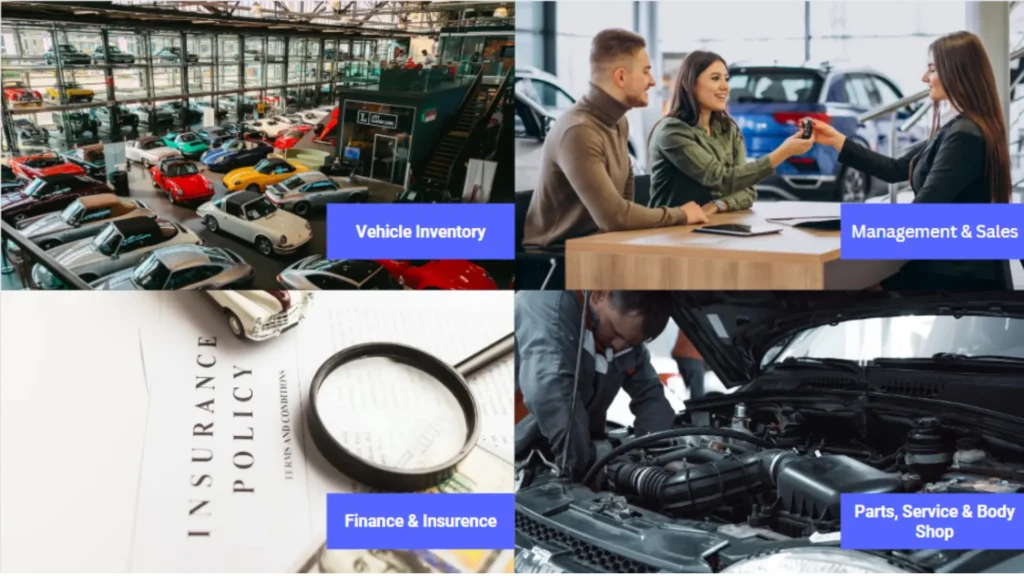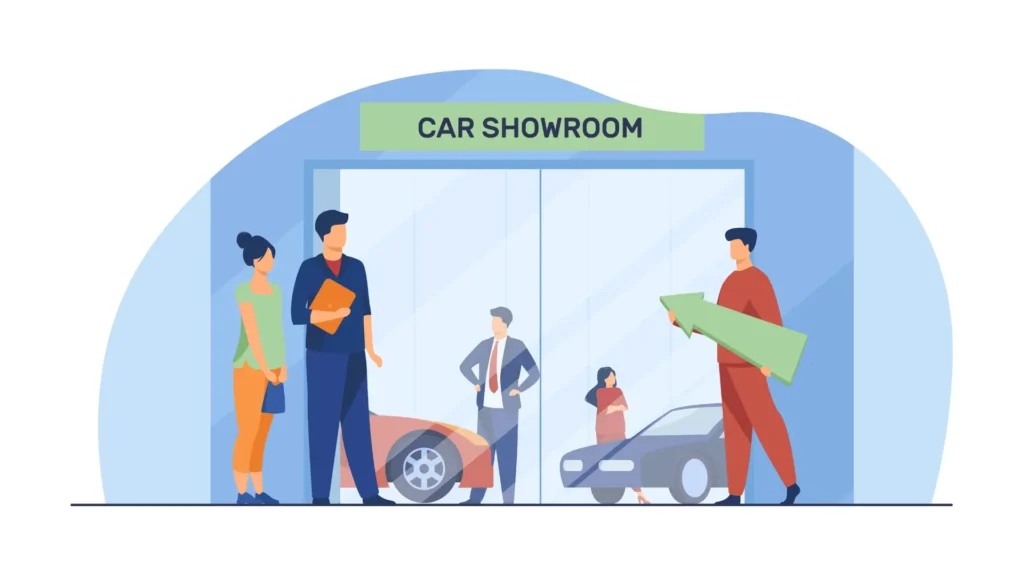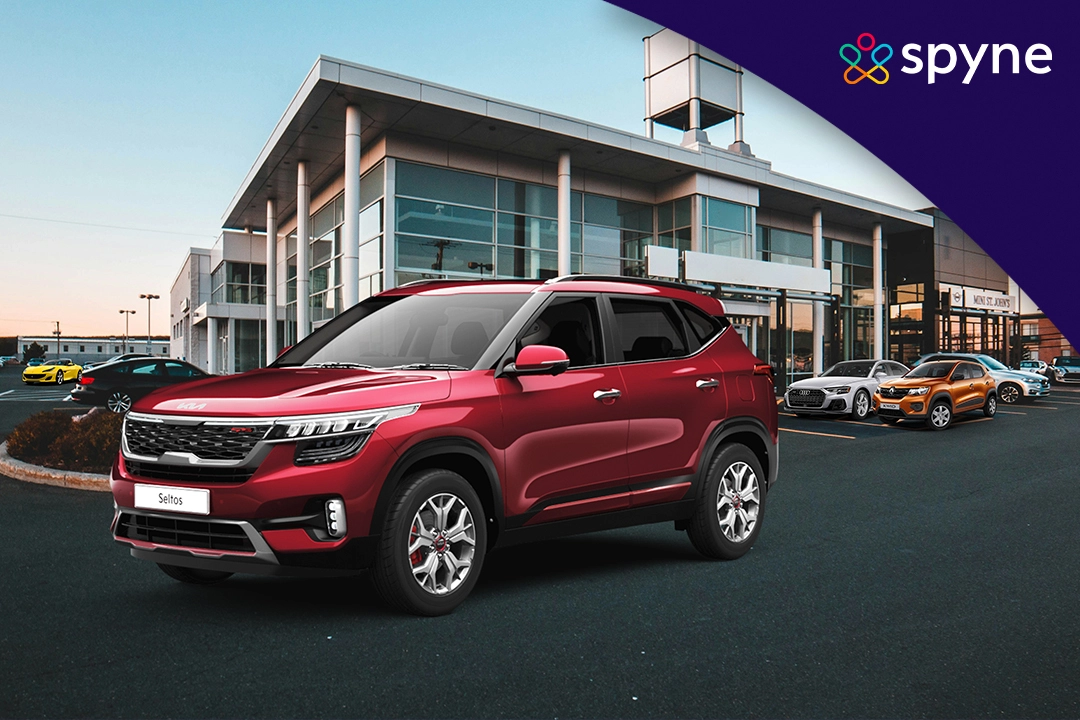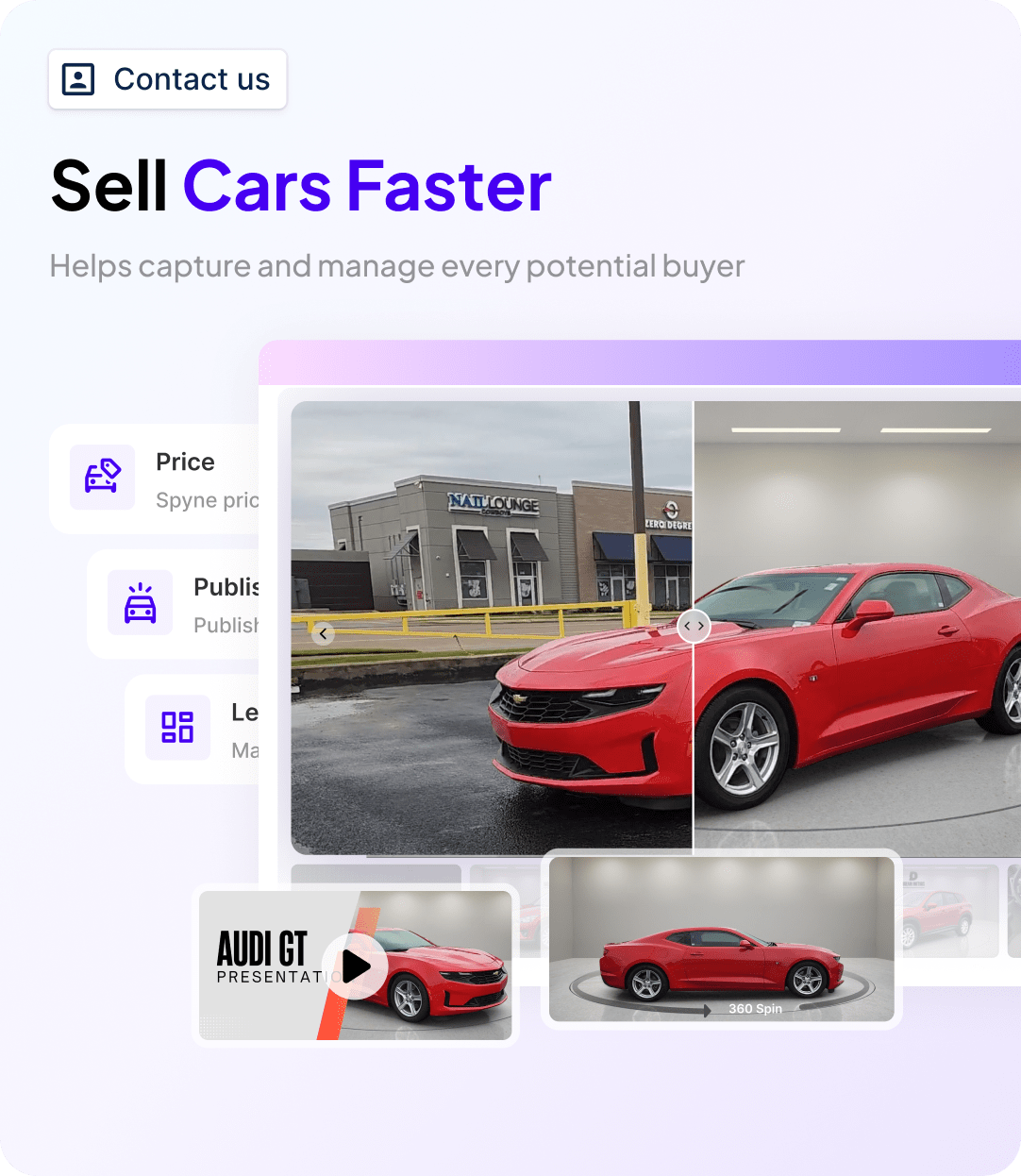Auto dealerships have always been an integral part of the automotive industry. They offer a range of services, including selling new and used cars, car financing, maintenance and repair services, etc. In recent years, the automotive dealership industry has seen significant growth due to technological advancements and changes in consumer behavior. Carmalls today are faced with a unique set of challenges and opportunities.
As technology evolves, auto dealerships must adapt to stay relevant and competitive. Therefore, this includes implementing new tools and systems to streamline operations, improve customer experiences, and drive revenue growth. In this blog, we will explore the world of auto dealerships. We will examine how they operate, how to start a car dealership, and what offerings can attract customers. Let’s begin.
What is an Automotive Dealership?
An automotive dealership is a retail business that sells or leases used or new cars. Car dealerships act as a middleman between vehicle manufacturers and car buyers. Car dealerships also earn revenue by selling vehicle spare parts and providing automotive maintenance services. They operate under a dealership agreement with a sales subsidiary or a specific automaker, which allows them to sell new or used vehicles. Car dealerships play an important role in local and state taxes.
How Does a Car Dealership Work?
Automotive dealerships provide a range of services, including selling and buying of vehicles. Specific companies often franchise an auto dealership to sell and service their vehicles. Therefore, they have physical showrooms that house the used and new vehicles to be sold, areas for offering mechanical services, and repair facilities. Whereas, the State Law prohibits US car dealerships from buying from the manufacturer directly. Here we discuss the working of various departments of a car dealership.

1) Vehicle Inventory
Used cars are bought through trade-ins or direct purchases. Dealerships use floor plan financing to buy inventory and pay interest on the amount for the period that a car stays in their lot. This means the quicker the car sells, the better. Discounts are used to sell cars that are sitting on the lot for a long period because the primary concern then shifts from making a profit to getting rid of the old inventory.
2) Pricing and Incentives
Some prices can be negotiated, while on other vehicles, the dealership is required to follow strict pricing guidelines. An automotive dealership can get ‘hold-back’ money from the manufacturer, along with other incentives and rebates on new cars. In the case of used cars, the selling price is decided based on what is paid to buy the vehicle and recondition it.
3) Management and Sales
The owner acts as a dealer principal if he owns a single dealership and appoints managers if he owns more than one dealership. The manager looks after the day-to-day operations depending on their agreement with the principal. The manager often needs to buy in as a minority partner and is given bonuses for achieving targets or unusually high profits.
4) Finance and Insurance
F&I, or the car dealer finance and insurance department, takes care of the financing for customers. Therefore, this department makes money by selling the car for a loan using the dealership reserve, earning a profit from the interest charged. Selling of insurance and warranties and the paperwork associated with a vehicle purchase are all taken care of by the F&I department. This department is often called the front end of a dealership.
5) Parts, Service, and Body Shop
Where F&I is the front end, the service, parts, and body shop department are the back end of a car dealership. They take care of servicing the vehicle after it has been sold to a customer. They help increase customer interactions and dealership revenue, but not all dealerships have these car dealership departments. Nowadays, car dealership DMS (dealer management software) is available for this function.
Types of Automotive Dealerships
There are different types of car dealerships, each with their own focus. Whether you are looking for a new car or a pre-owned vehicle, understanding the different classifications will empower you to make an informative and strong decision. Here, we have listed some of the common types of car dealerships:
| Types of Automotive Dealerships | Features |
| New Auto Dealerships | These dealerships offer brand-new vehicles straight from the manufacturer. Usually, they are franchised, which means they have an agreement with a particular automaker to sell their cars. Whereas, a manufacturer’s many brands may be sold by certain dealerships. |
| Used Auto Dealerships | Secondhand car dealers sell previously owned vehicles. They can be independent or affiliated with a new automotive dealership. Some used auto dealerships specialize in certain types of vehicles, such as luxury cars, trucks, or SUVs. |
| Certified Pre-Owned Dealerships | These dealerships offer pre-owned vehicles that have undergone inspection and certification by the manufacturer based on a set of requirements. |
| Electric Vehicle Dealerships | As the EV market grows, dealerships dedicated to selling electric vehicles are becoming more common. These dealerships may also offer charging stations and other services for EV owners. |
Top 10 Benefits of Car Dealerships
Cars can be purchased from multiple sources. However, consumers still prefer shopping for a car dealership. So, what are the benefits these dealerships offer that increase shoppers’ loyalty and satisfaction? Here, we have mentioned the top benefits a car dealership has when you pick them up for your car shopping.
1) Price Competition
Dealerships are in fierce competition over prices, leading to lower costs and better customer service. There is transparency in pricing and negotiation. In the case of direct sales, the factory fixes the price, so there is no room for negotiation. The cost of showrooms, lots, staff, inventory holding, etc., is also involved in retail.
2) Consumer Safety
Dealerships ensure that warranty and safety issues are addressed efficiently. Additionally, incentives are given to dealers to respond quickly to the safety concerns of customers; automakers pay them to perform recall and warranty checks.
3) Local Economic Benefits
Dealerships provide jobs to the community and opportunities for professional development to their employees. Local car dealers’ profits also benefit the community; local auto malls hire local people.
4) Financing Options & Paperwork
Car dealers provide you with the best financing options to make cars more affordable. However, when it comes to purchasing a car from a lender, most of them do not provide any financing facility. Private sellers might provide you with the vehicle with an inaccurate value or the car might be in a worse condition. Private lenders prefer to deal in cash, which could be stressful for car buyers.
5) Quality Assurance with Certifications/Inspections
Car dealers maintain a solid reputation to keep their customers stress-free. Therefore, it ensures dealerships sell the vehicles. The vehicles sold are assured and passed various quality checkpoints, making it a fair deal for your purchase. Some dealers offer certified pre-owned vehicles and offer guarantees and warranties.
6) Variety of Vehicles
Automotive dealerships stock up their inventory with a variety of vehicles and their models. So the consumers can choose the best fit for themselves. Additionally, dealers offer a wide variety of additional service options, accessories, and promotional incentives.
7) Added Value
Dealerships simplify the complex process of buying a car. Therefore, they offer assistance with title, registration, and regulatory paperwork. Car dealers understand the needs and requirements of their consumers and assist new buyers with the technical process.
8) Post-sale Services
Dealers offer qualified technicians to perform regular car maintenance. Dealers offer a maintenance contract with your purchase to keep your car in a hale and heart condition. Whereas, once you want to upgrade the vehicle after a few years of ownership, dealers accept and help in the trade with a newly designed mode.
9) Reputable Business
Car dealerships focus on providing exceptional service to make their customers happy and satisfied. Their customer-centric approach makes their dealership a reputable business in the market. Additionally, a well-known dealership is more likely to get repetitive and new customers.
10) Knowledge and Expertise
A dealership often has well-known and experienced employees who serve their clients. They take care of their customer’s needs and budgets and offer them helpful suggestions. Shoppers prefer visiting the dealership to get a user-friendly and satisfactory experience.
Most Common Challenges Faced by Automotive Dealerships
Car dealership businesses are dealing with the biggest challenges nowadays, such as high costs and a depleted inventory. We have mentioned the most common challenges and difficulties dealerships are facing across the success of their business.
1) Supply Chain Disruptions: There are massive disruptions in the global supply chain, which started during the pandemic and led to delays in the delivery of cars, their parts, and other goods.
2) Rising Costs: Costs for labor and materials are rapidly increasing and reducing the dealer’s profit margin. Additionally, because of this, dealers raise the price of the vehicles to stay in business.
3) Change in Customer Expectations: Car buyer’s purchasing preferences are evolving. They look for a clear, fast, and personalized experience. Many dealerships are facing difficulties to adapt the changing behavior of their target audience.
4) Shortage of Semiconductor Chips: The global chip shortage has hit car dealerships hard, leading to fewer cars and higher prices. However, as chip supply improves, car prices could stabilize, and manufacturers may manage inventory tightly to keep prices steady and reduce discounts.
5) Growing Number of Vehicle Thefts: It has been observed that the number of vehicles being stolen from the dealership’s lot has increased massively in the past few years. Therefore, it will increase the expenditure of the business.
6) EV Adaption: EVs are becoming popular. However, dealerships might find difficulties adapting sales strategies, inventory management, and infrastructure. Additionally, they might need to educate employees about the latest EV technologies.
7) Cyber Security Risks: It is essential for auto dealerships to protect their data from data breaches and ransomware attacks.
Nature of the Automobile Dealers Industry
Auto dealerships link car manufacturers and consumers. Therefore, they provide a wide range of vehicles at different prices to customers. Here we try to understand a car dealership business model by looking at its nature and work environment.
1) Goods and services: A car dealership sells most of the automobiles, vans, and light trucks. The sale of a vehicle can vary depending on consumer taste. Dealerships also offer auto-related services through aftermarket sales departments, including repairs, refinishing, and painting. Apart from generating revenue, this also improves customer satisfaction. Incentives, financing deals, and rebates are offered to customers during slow periods to maintain sales and reduce inventory.

2) Industry organization: New car dealers that sell new cars, SUVs, passenger and cargo vans, and used car dealers that sell previously owned or rented and leased vehicles make up the two segments of the automotive dealership industry. According to NADA, more than half of total sales revenue is due to new vehicle sales. Best used car dealerships in New York are also expanding to open stores across the country.
3) Recent developments: Used car sales are earning huge profits while margins of new car sales are shrinking. Automalls now offer certified pre-owned vehicles for customers who want a warranty on their used vehicles. Aftermarket services like vehicle maintenance, repair, and financing are increasing efficiency and flexibility. Apart from sales, car rentals, and leasing, where customers make monthly payments and eventually return the vehicle, dealerships are also incorporating these to increase profits and attract a broader customer base.
What is the Role of Technology in Automotive Dealerships?
Smart technologies like machine learning and AI integrated into the automobile dealership will help the business personalize its marketing strategies by predicting customers’ preferences and optimizing its car inventory accordingly.
Necessary for a Car Dealership Success
- Customer Relationship Management (CRM): Automotive CRM software system allows dealerships to manage their company’s interaction with their customers. It helps to improve the relationship between both parties and grow the success of your business.
- Dealer Management System (DMS): It is a business management automotive software that helps dealerships to manage their day-to-day business activities. Additionally, it provides real-time and historical data to the vehicle fleet business.
Benefits of Modern Technologies in Good Car Dealerships
- Enhanced Customer Experience: Advanced tools like AR & VR allow interested shoppers to preview the vehicle in detail from their homes. These technologies allow customers to have a virtual test drive, inspect car experience, and more without visiting the dealership.
- Automation in Operations: Automated tools and technologies reduce the manual work required and also minimize errors. The right auto inventory platform will ensure that operations run smoothly.
- Integration and Innovation: Smart tools like AI and machine learning will improve dealership operations smoothly and help dealers make data-driven decisions.
Top 20 Trends in the Automotive Dealership Industry
The car dealership industry is witnessing several evolving trends shaped by technological advancements, changes in consumer preferences, and broader economic factors. Here are key trends impacting this sector:
1) Connected Cars and Digital Technology: Dealerships are showcasing cars with advanced digital features, appealing to tech-savvy consumers.
2) Autonomous Vehicle Development: There’s an increasing introduction of semi-autonomous features in cars, as the industry works towards fully autonomous vehicles. Therefore, these vehicles can run with no human input.
3) Shared Transport: The rise in shared transportation services is leading dealerships to explore shared ownership models and partnerships with ride-sharing companies.
4) Automaker and Tech Company Collaborations: Automakers are partnering with tech companies to integrate cutting-edge technology into vehicles.
5) Electric Vehicle Growth: Increase in production of digital vehicles and dealerships are expanding their electric vehicle offerings in response to increased consumer demand and sustainability initiatives.
6) Sales Slowdown: Changing sales experience and economic challenges have caused a decrease in car sales, leading to enhanced customer experiences and flexible financing options in automotive dealerships.
7) Subscription Plans by Automakers: Some automakers are experimenting with vehicle subscription services as an alternative to traditional ownership.
8) Mobile Marketing Emphasis: Dealerships are focusing on mobile marketing strategies, including mobile-optimized best car sales websites and targeted ads.
9) Augmented Reality in Showrooms: AR technology is used for virtual test drives and interactive car features.
10) Automotive Marketing Trends: Personalization and automotive digital marketing are increasingly important for engaging customers.
11) Global Increase in EV Adoption: There’s a worldwide trend towards electric vehicles, influencing dealership inventory and marketing.
12) Automotive Digital Retail: Vehicle purchases shift towards online car shopping is leading dealerships to enhance their digital retail platforms. Also, maintain related blogs. Additionally, these trends reflect a shift towards more technologically advanced, sustainable, and customer-focused practices in the automotive dealership industry.
13) AI (Artificial Intelligence): AI technology is transforming the automotive industry by providing a personalized experience to consumers to predict automotive inventory management. Additionally, to lead in innovation and customer engagement, dealers need to adopt AI-driven technologies.
14) VR (Virtual Reality): Consumers want to experience the feel of their desired vehicle from their home itself, before visiting an actual physical store. VR technology allows the automotive industry to provide a virtual experience to their clients.
15) Data analytics: The usage of big data analytics in the automotive retail sector would be increased. Understanding the consumer’s preferences, needs, habits, and personalized experience and lead to more targeted marketing campaigns.
16) Sustainable and eco-friendly practices: We get to see a trend of consumers shifting to EVs and hybrid vehicles to protect the environment. Apart from that, automotive companies are taking the initiative to make green production in their manufacturing process to make a safer environment for everyone.
17) Online sales: Automotive industries are aware that consumers’ preferences are shifting to online purchases. They are developing strategies to boost their online marketing and sales with a smooth and convenient deal for their clients.
18) Mobile marketing strategy: As per the research consumer’s common place to shop is on their mobile and no wonder while being at the physical showroom consumers buffer their mobile for research and fair deals. Automotive digital retailers who are not grabbing the opportunity of mobile marketing are likely to lose 72% of their conversions. Therefore, consumers are attracted to mobile marketing to buffer for the best available deals.
19) Used car retail growth: Demand for used cars is increasing. Consumers’ behavior is shifting to purchase 3-4-year-old used cars, which offer almost all the required features and are inexpensive as compared to new models.
20) Social media advertisement: As social media platforms are evolving, you can create engaging marketing content to reach a wide audience. Therefore, traffic from social media marketing would be massive.
How Spyne Helps Automotive Dealerships?
Spyne’s AI-powered tools can help an automotive dealership business by enhancing vehicle presentations, improving marketing efforts, streamlining operations, and providing a better overall customer experience.
1) Enhanced Vehicle Presentation
Spyne provides customized and tailored (studio/outdoor) backgrounds to vehicle images that make each listing look more professional and visually appealing.
2) Turntable and 360 Spins
Offering interactive 360-degree spins and turntable views allows customers to examine vehicles from every angle, improving their online shopping experience and reducing the need for in-person visits.
3) Improved Image Quality
Spyne’s AI-driven tools can enhance the quality of vehicle photos, making them sharper and more vibrant. This helps in presenting the vehicles in their best light and can lead to higher engagement from buyers.
4) Professional Online Presence
Spyne provides customizable car dealer website templates that can help dealerships build a professional, user-friendly online presence. Therefore, this can enhance the dealership’s brand image and make it easier for customers to browse and purchase vehicles.
5) Operational Efficiency
Spyne’s Dealership Management System (DMS) can integrate various dealership operations, such as sales, service, and inventory management, into one streamlined platform. This can improve efficiency, reduce manual work, and provide better insights into dealership performance.
Conclusion
Automotive dealerships are an integral part of the automotive industry. Various departments take care of the car dealership operations, from inventory management to F&I services. Employees of these departments contribute to the dealership’s efficient working, and training them can drive up sales. The industry faces a dynamic future shaped by evolving technology, consumer preferences, and regulatory landscapes. Dealerships must adapt to decreasing margins, leverage technological advancements, and respond to changing consumer trends, including the rise of shared mobility and subscription models. Additionally, navigating these challenges and opportunities requires innovation, customer-centric approaches, and a keen understanding of market fluctuations.

















